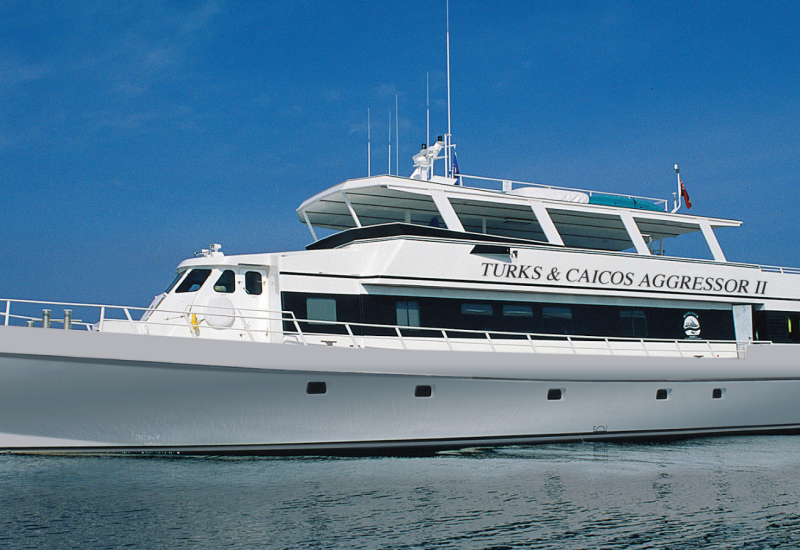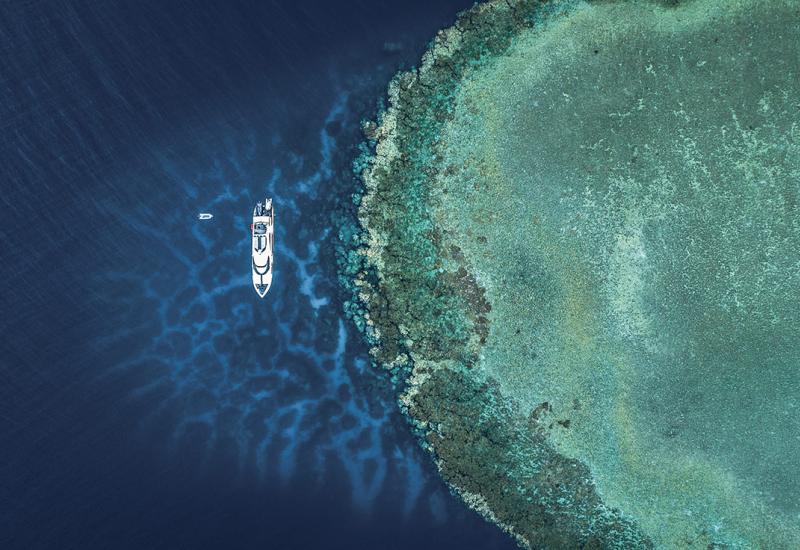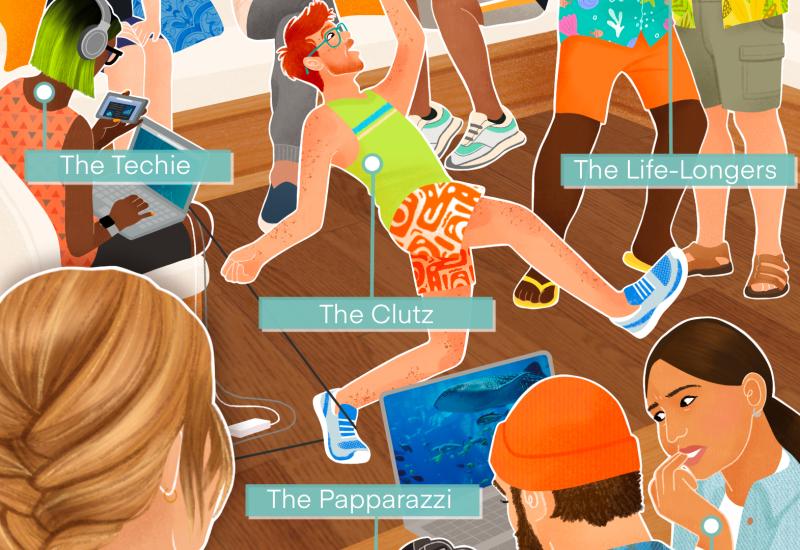Dive Hacks: Expert Tips for Liveaboard Adventures
Savvy divers know that liveaboards are the ultimate way to travel for maximum water time and major pampering. These floating palaces of dive lust cruise some of the most exotic and prolific regions on the planet, putting their guests into the best possible conditions at optimal times for mind-blowing encounters. When your plush stateroom and gourmet meals are bobbing gently above a world-class dive site, a vacation doesn’t get much easier. All that’s required is to roll out of bed and into your wetsuit, because your gear is already assembled and waiting for you, attached to a full cylinder. Consider enjoying this scenario for seven to 10 days in a row, and the fantasy that is liveaboard diving comes into clear and wonderful focus.
All of this bliss comes at a price, however. This method of travel represents a significant investment, one that frequently cashes out at a more expensive price tag than a land-based alternative. And because you’re typically isolated from civilization, it pays to come prepared with a highly tuned game plan, the right equipment and a few tricks to which only liveaboard veterans are privy. To even the playing field for every diver, I asked Lauren Hill, the New Zealand-born captain of the Aggressor Fleet’s Cayman Aggressor IV, for her expert advice. A veteran of six years at the helm and a half-dozen more as an instructor and guide, Hill is one of the most customer-focused liveaboard hosts I’ve ever encountered; her advice can help you make the most of your luxury-travel investment.
BE THE EARLY BIRD
Diving from a liveaboard means that, more often than not, you’ll be anchored in a prime spot that day boats can take considerable time to reach. And captains know how to maximize local conditions to serve up the best spots on any given day. Advantage: you. So make the most of the opportunity by rising with the sun and being there when the reef comes to life. Piloting the CAIV gives Hill early-bird entry to some of her favorite sites in the Caymans: “Nancy’s Cup of Tea on Little Cayman as a dawn dive is always a ‘wow’ dive when the reef is waking up around you and the reef sharks come in close to check us out.”
PLAN TO TAKE YOUR TIME
Without the pressure land-based operators have to get their guests in the water and back on a schedule, liveaboard divers have the ultimate luxury of time. Whether you’re diving from the yacht or by tender, the relaxed schedule can take some getting used to. “As all our dives are from the mothership, there is no need to take of on a mission swimming 2 miles away underwater,” says Hill. “All our dives are right under the boat, so our guests can slow down and smell the roses — and relax.”
BRING A BACKUP FOR YOUR BACKUP
The glorious isolation of being on a yacht far out at sea is a fantasy many of us share. But it can quickly turn into a nightmare when equipment malfunctions and you can’t hit the local dive store for that key part or replacement piece. “A big mistake our divers make is not testing their gear after having it serviced,” Hill says. “First dive of the week, and we have free-flowing this and malfunctioning that and the cry of, ‘But I just had it serviced.’ Go for a couple of local dives at home before your trip, even if it’s just in the pool.” You can’t always count on the boat staff to have a particular part, so a well-stocked save-a-dive kit is a must.
Hill advises that “having backup equipment if you own an unusual brand, for example, or a spare battery for your flashlight that regular batteries don’t fit,” can help liveaboard guests avoid missing dives when disaster strikes. “And photographers should pack backup fiber-optic cables and strobe connectors, and a backup SD card or hard drive too.”
MIND YOUR CORE
With the availability of up to five dives per day, liveaboard guests can rack up serious bottom time, but they can also chill themselves to the verge of hypothermia — even in tropical waters. Being mindful of your internal body temperature can be the difference between performing at your best and shivering in discomfort.
“I always encourage guests to get completely dry and changed between dives,” Hill says. “Your core temp will warm up faster, and you will probably stay warmer and enjoy the next dive even more.”
MAKE THE BEST OF CLOSE QUARTERS
You’ll be on board with the same group of strangers for an extended period. Even though a common love of diving is a great icebreaker, Hill has seen enough good and bad chemistry experiments to pick up a few best practices. “There are a few key ways to make friends or just get along when you are on a yacht for a week or more,” she says. “In your cabin and on the dive deck, keep your belongings, equipment, and diving and photo gear all in your space. Don’t be that guy or gal who takes over the cabin or the dive deck with all of your worldly possessions.”
Hill’s final piece of advice: “Try not to be a know-it-all,” she says. “It’s great that you are enthusiastic and you have all of this knowledge to share, but don’t force it upon your fellow divers — you’ll only drive them away. Move around the group, sitting with different people at mealtimes, and just be social. Best of all, just relax, bring a sense of humor and enjoy the ride.”
GEAR SOLUTIONS: PACKING LIST
Capt. Lauren Hill’s recommended scuba accessories and common household items to make the most of your liveaboard trip.
A GOOD FLASHLIGHT Think small, bright and rechargeable (or with plenty of extra batteries).
SURFACE-MARKER BUOY Make sure you never dive without one.
TWO OR THREE SWIMSUITS So you’ll always have a dry one.
BATTERIES Bring backups for your computer, camera and everything else that uses them.
SUNSCREEN Nothing is worse than getting fried your first day on board, then suffering the rest of the week
when you strap your BC on sunburned shoulders.
SEASICKNESS MEDS Be proactive about taking them, because when it’s too late, it’s too late.
CONDITIONER Girls or guys with long hair, not all boats supply it (your hair will appreciate it).
PRESENTS FOR THE CAPTAIN AND CREW Bring (and leave on the boat) DVDs of new movies and TV series, books, magazines, etc. The crew will love you.
Click here for liveaboard dive deals and for some of our favorite liveaboard destinations!
Savvy divers know that liveaboards are the ultimate way to travel for maximum water time and major pampering. These floating palaces of dive lust cruise some of the most exotic and prolific regions on the planet, putting their guests into the best possible conditions at optimal times for mind-blowing encounters. When your plush stateroom and gourmet meals are bobbing gently above a world-class dive site, a vacation doesn’t get much easier. All that’s required is to roll out of bed and into your wetsuit, because your gear is already assembled and waiting for you, attached to a full cylinder. Consider enjoying this scenario for seven to 10 days in a row, and the fantasy that is liveaboard diving comes into clear and wonderful focus.

Aggressor.comThese tips will have you lovin' the liveaboard life
All of this bliss comes at a price, however. This method of travel represents a significant investment, one that frequently cashes out at a more expensive price tag than a land-based alternative. And because you’re typically isolated from civilization, it pays to come prepared with a highly tuned game plan, the right equipment and a few tricks to which only liveaboard veterans are privy. To even the playing field for every diver, I asked Lauren Hill, the New Zealand-born captain of the Aggressor Fleet’s Cayman Aggressor IV, for her expert advice. A veteran of six years at the helm and a half-dozen more as an instructor and guide, Hill is one of the most customer-focused liveaboard hosts I’ve ever encountered; her advice can help you make the most of your luxury-travel investment.
BE THE EARLY BIRD
Diving from a liveaboard means that, more often than not, you’ll be anchored in a prime spot that day boats can take considerable time to reach. And captains know how to maximize local conditions to serve up the best spots on any given day. Advantage: you. So make the most of the opportunity by rising with the sun and being there when the reef comes to life. Piloting the CAIV gives Hill early-bird entry to some of her favorite sites in the Caymans: “Nancy’s Cup of Tea on Little Cayman as a dawn dive is always a ‘wow’ dive when the reef is waking up around you and the reef sharks come in close to check us out.”
PLAN TO TAKE YOUR TIME
Without the pressure land-based operators have to get their guests in the water and back on a schedule, liveaboard divers have the ultimate luxury of time. Whether you’re diving from the yacht or by tender, the relaxed schedule can take some getting used to. “As all our dives are from the mothership, there is no need to take of on a mission swimming 2 miles away underwater,” says Hill. “All our dives are right under the boat, so our guests can slow down and smell the roses — and relax.”

Zach StovallBring reliable gear (and backup gear!) to avoid missing out on dives
BRING A BACKUP FOR YOUR BACKUP
The glorious isolation of being on a yacht far out at sea is a fantasy many of us share. But it can quickly turn into a nightmare when equipment malfunctions and you can’t hit the local dive store for that key part or replacement piece. “A big mistake our divers make is not testing their gear after having it serviced,” Hill says. “First dive of the week, and we have free-flowing this and malfunctioning that and the cry of, ‘But I just had it serviced.’ Go for a couple of local dives at home before your trip, even if it’s just in the pool.” You can’t always count on the boat staff to have a particular part, so a well-stocked save-a-dive kit is a must.
Hill advises that “having backup equipment if you own an unusual brand, for example, or a spare battery for your flashlight that regular batteries don’t fit,” can help liveaboard guests avoid missing dives when disaster strikes. “And photographers should pack backup fiber-optic cables and strobe connectors, and a backup SD card or hard drive too.”
MIND YOUR CORE
With the availability of up to five dives per day, liveaboard guests can rack up serious bottom time, but they can also chill themselves to the verge of hypothermia — even in tropical waters. Being mindful of your internal body temperature can be the difference between performing at your best and shivering in discomfort.
“I always encourage guests to get completely dry and changed between dives,” Hill says. “Your core temp will warm up faster, and you will probably stay warmer and enjoy the next dive even more.”
MAKE THE BEST OF CLOSE QUARTERS
You’ll be on board with the same group of strangers for an extended period. Even though a common love of diving is a great icebreaker, Hill has seen enough good and bad chemistry experiments to pick up a few best practices. “There are a few key ways to make friends or just get along when you are on a yacht for a week or more,” she says. “In your cabin and on the dive deck, keep your belongings, equipment, and diving and photo gear all in your space. Don’t be that guy or gal who takes over the cabin or the dive deck with all of your worldly possessions.”
Hill’s final piece of advice: “Try not to be a know-it-all,” she says. “It’s great that you are enthusiastic and you have all of this knowledge to share, but don’t force it upon your fellow divers — you’ll only drive them away. Move around the group, sitting with different people at mealtimes, and just be social. Best of all, just relax, bring a sense of humor and enjoy the ride.”
GEAR SOLUTIONS: PACKING LIST
Capt. Lauren Hill’s recommended scuba accessories and common household items to make the most of your liveaboard trip.
A GOOD FLASHLIGHT Think small, bright and rechargeable (or with plenty of extra batteries).
SURFACE-MARKER BUOY Make sure you never dive without one.
TWO OR THREE SWIMSUITS So you’ll always have a dry one.
BATTERIES Bring backups for your computer, camera and everything else that uses them.
SUNSCREEN Nothing is worse than getting fried your first day on board, then suffering the rest of the week when you strap your BC on sunburned shoulders.
SEASICKNESS MEDS Be proactive about taking them, because when it’s too late, it’s too late.
CONDITIONER Girls or guys with long hair, not all boats supply it (your hair will appreciate it).
PRESENTS FOR THE CAPTAIN AND CREW Bring (and leave on the boat) DVDs of new movies and TV series, books, magazines, etc. The crew will love you.
Click here for liveaboard dive deals and for some of our favorite liveaboard destinations!










